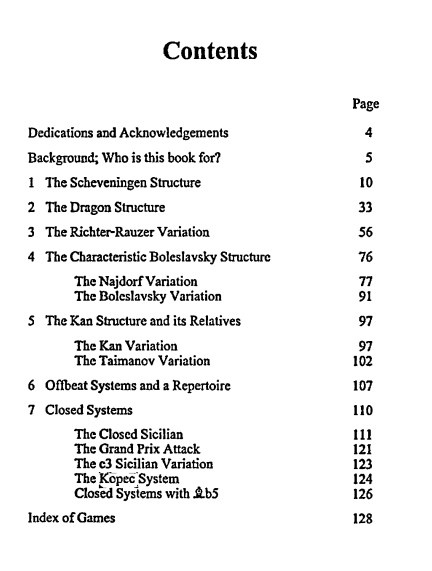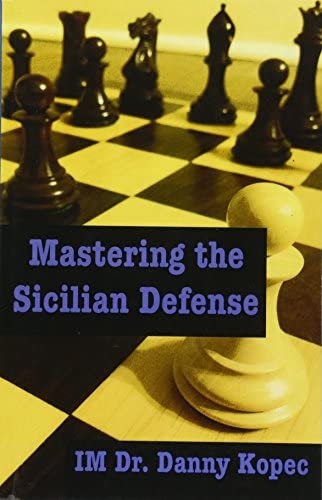Disclaimer 1: The following article contains several affiliate links to Amazon.com, meaning that if you go to Amazon and buy the recommended product (or some other product in an allotted period of time), the author of these lines will get a commission % from the purchase
Disclaimer 2: The following article is an excerpt from my article titled Best Chess Books 2022 in which I reviewed 20 chess books
Danny Kopec: Mastering The Sicilian
Somewhere at the beginning of 2021, I decided to do significant work on my opening repertoire. Aside from adding Grünfeld against 1.d4, I also decided to expand my repertoire against 1.e4 and stop playing the Modern exclusively. Apart from returning to my old love Alekhine, I also figured I might want to add a real, healthy opening to the mix. An opening that is more mainstream, yet still leads to the combative play. Thus, picking up 1…c5 was a natural choice – especially since Sicilian structures can also often be reached via the Modern move order.
However, similarly, as with Grünfeld, I realized that I should probably study some middlegames and typical games instead of solely clicking through the lines in Chessbase/Movetrainer. And even though I did get the impression that the Sicilian structures are much better covered in the chess literature than the Grünfeld structures, 1 I was still happy when my coach recommended the book Mastering The Sicilian by American International Master Danny Kopec and I promptly got down to reading it.
Mastering the Sicilian is basically a book on Sicilian Structures. In the first 5 chapters, the author covers some of the most common Sicilian structures out there, as follows:
- The Scheveningen Structure
- The Dragon Structure
- The Rauzer Structure
- The Boleslavsky Structure
- The Kan Structure
The final two chapters are devoted to rare Sicilians and provide some insight into systems such as Closed Sicilian, Grand Prix, etc. Thus, even though this book is aimed at Sicilian players, it is not necessary for a Sicilian player to read every chapter, but only that refer to structures related to the variation of the Sicilian you play. Thus, if you are a Dragon player, you can probably only focus on the second and the seventh chapter of the book and ignore the rest.

As you might have figured out by now, this book is not a theoretical manual, but rather a middlegame book. Every chapter starts with a relatively detailed elaboration of the structure at hand and consists of a set of model games featuring that very structure displaying a variety of possible plans and ideas for both sides.
As a matter of fact, I think this emphasis on typical plans and ideas is the best thing about this book. Before every game, the author provides the reader with the so-called „Mastery Lesson” box, outlining the most important and instructive moments, maneuvers, and themes for every single game.

I think such a streamlined approach is absolutely necessary for a „structure-oriented” book. It is not a coincidence that the aforementioned Chess Structures: A Grandmaster Guide implements a very similar approach.
As for the annotations and the analysis of the games themselves, they leave a lot to be desired. The commentary is very sparse, both in terms of density (how many moves are actually annotated) and the number of words used. Most commentary resorts to the typical „XYZ is equal” grandmaster remarks or to the standard „let me give a long variation with a lot of moves and no explanations to prove a point”. Since I knew from the very start I want to focus on ideas and play through a bunch of games without necessarily being concerned by the accuracy of the analysis, I didn’t even bother to check it too thoroughly, but one does get the impression that the book was scraped hastily, somewhat lazily and without too much attention to details.
This haste is especially apparent if we consider the general size of the book (only ~130 pages), the fact that the sixth chapter devoted to rare 2nd moves is only 3 pages long, or if we consider the visual design of the book. The distribution of the diagram, the outline of the elements on pages, and the general visual identity of the book are simply atrocious and I can’t be left wondering where on Earth was the editorial input in regard to these matters?

Thus, even though the book features a nice collection of games and contains instructive lessons for a Sicilian player, it leaves a lot to be desired. It is definitely not sufficient in itself to help you „Master the Sicilian”. 2
If I were to rate it, I would hardly give it more than, say, 3 stars out of 5. Even though you might find a lot of value in it if you are a Sicilian player just starting your journey through the 1.e4 c5 waters, I think you are better off buying another designated Sicilian book (say, Starting Out: The Sicilian) or another book featuring the Sicilian structure (such as the aforementioned Chess Structures: A Grandmaster Guide).
- For example, there are quite a few chapters devoted to typical Sicilian structures in the renowned book Chess Structures: A Grandmaster Guide. While the same can’t be said for the Grünfeld structures.
- TBH it can hardly be achieved by ANY single book – but it can definitely not be achieved solely by reading this one.

